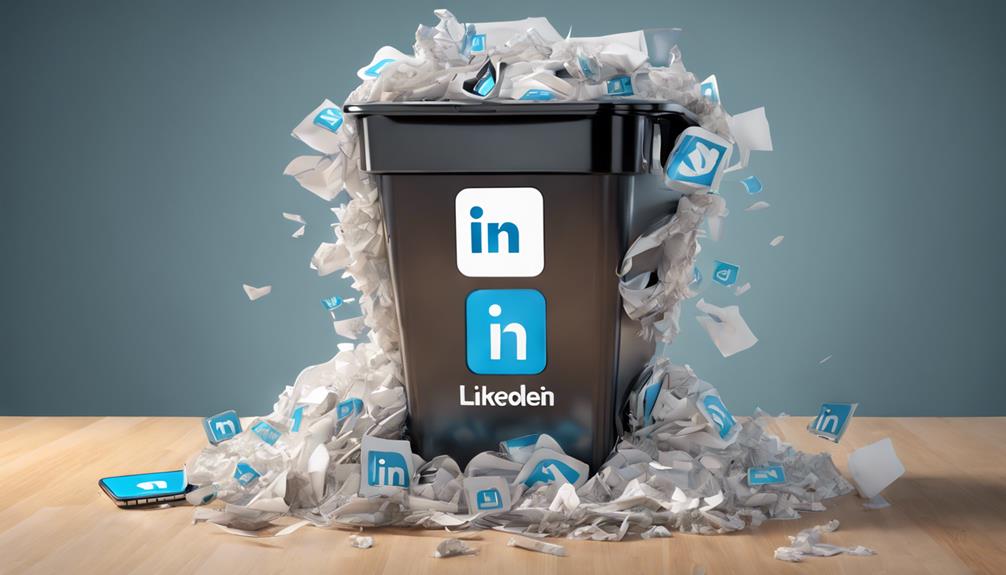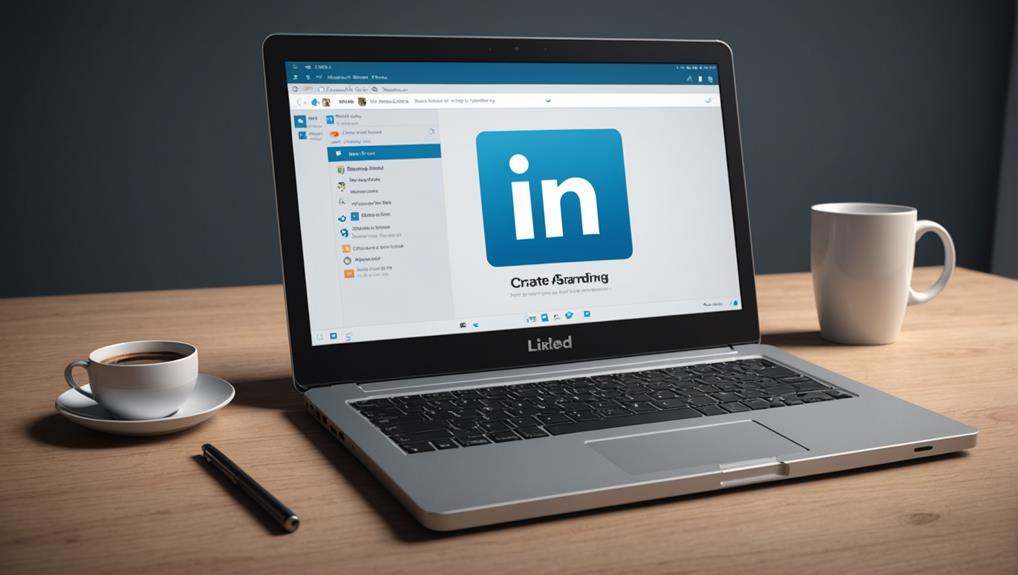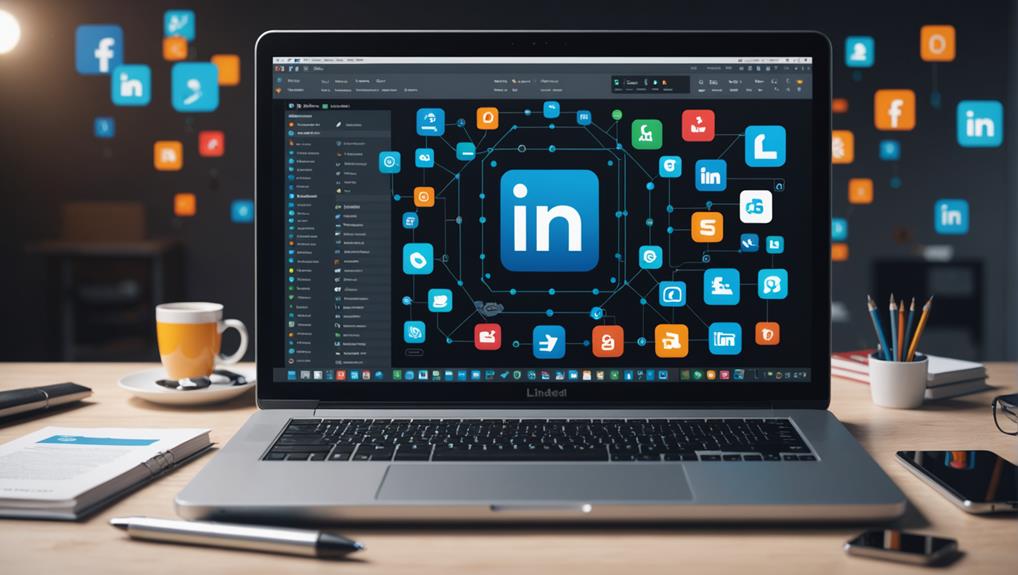
Unfortunately, you can't directly recover deleted LinkedIn messages once they're gone from your inbox. If you haven't backed them up or archived them, your best bet is to check your email notifications, as LinkedIn often sends copies of messages there. You might also consider reaching out to the sender to ask if they can resend the information. For future reference, it's a good idea to make regular backups using LinkedIn's data export tool, which includes your messages. This proactive step can save you a lot of trouble. There's more you can explore to ensure you're better prepared next time.
Understanding LinkedIn's Messaging System

LinkedIn's messaging system allows you to communicate directly with other professionals in your network. It's a powerful tool for staying connected, sharing insights, and fostering relationships that can advance your career. As you navigate through the platform, you'll find that these interactions aren't just exchanges of information but are building blocks for a supportive community.
You're not just sending messages; you're engaging in conversations that can lead to new opportunities and collaborations. Whether you're reaching out to a potential mentor or touching base with a colleague, every message can strengthen the bonds within your professional circle. The system is designed to be intuitive, ensuring you can easily start and maintain these vital connections.
Moreover, LinkedIn's interface allows you to organize your conversations effectively, helping you keep track of ongoing discussions and ensuring you don't miss out on any important details. It's all about making sure you feel integrated and valued within your professional community. By actively participating, you're not only enhancing your visibility but also contributing to a network that thrives on mutual support and respect. Remember, each message you send is a step towards building a stronger, more connected professional identity.
Common Reasons for Deleting Messages
You might delete messages to declutter your inbox or remove outdated information that no longer serves a purpose. It's not just about keeping things tidy; it's about maintaining an environment where you can focus on what truly matters. After all, a clean inbox is like a clean mind, right?
You might also choose to delete messages that contain sensitive information, especially if you're worried about data breaches or privacy concerns. In a world where your digital footprint can be as visible as your real-life presence, protecting your privacy isn't just cautious; it's necessary.
Sometimes, you might delete conversations that remind you of unsuccessful job applications or projects that didn't pan out. Letting go of these interactions can be a way to move forward, embracing new opportunities without the baggage of the past weighing you down. It's about clearing the way for new connections that can propel your career forward.
And, let's not forget the emotional aspect. Sometimes, messages can stir up emotions that you'd rather not deal with during your professional day. Deleting such messages can help you maintain your composure and stay focused on your professional relationships and goals.
Initial Steps to Retrieve Messages

While it's necessary to delete certain messages, retrieving them later may also be important. You're not alone in this; many people find themselves needing to dig up old conversations. Whether it's for reconnecting with a lost business contact or retrieving a vital piece of information you accidentally discarded, the first steps you take can significantly impact your success in recovering these messages.
Firstly, check if you've archived the message instead of deleting it. Many times, what feels like a deleted message is merely hidden away. Go through your archived messages to see if what you're looking for is there.
Next, try searching your email notifications. LinkedIn sends notifications for most interactions, including messages. If you have email notifications enabled, search your email for any traces of the deleted conversation. Often, these emails can contain the full message you previously received on LinkedIn.
Lastly, reach out directly. If you remember who sent the message, contacting them can be a straightforward solution. Most people will understand your situation and could resend the information or summarize the conversation for you. It's a simple yet effective way to reclaim what you've lost and reconnect with your network.
LinkedIn's Official Recovery Options
Unfortunately, LinkedIn doesn't offer a direct method for recovering messages once they're deleted from your account. This might feel a bit isolating, especially when you realize that an important connection or piece of information seems lost forever. However, you're not alone in this. Many users face this same challenge, and the sense of community in seeking solutions can be quite comforting.
While LinkedIn itself doesn't provide a recovery feature for deleted messages, understanding this limitation can help you adapt your approach to message management in the future. Think of it as a learning curve, one that everyone in your network navigates at some point. The key here is to start incorporating habits like taking screenshots of crucial conversations or backing up important messages externally. This proactive approach not only helps in safeguarding your valuable information but also strengthens your networking strategy.
Third-Party Tools and Services

Third-party tools and services can offer alternative solutions for recovering deleted LinkedIn messages. When you've tried everything official and it feels like you're out of options, these tools step in as your next best friends. They're built to dig deeper and retrieve what's gone — making you feel less alone in your quest to regain lost information.
You might find comfort in knowing that many others are in the same boat, seeking ways to pull back those important messages that slipped away. Tools like Recuva or Stellar Data Recovery are popular among users like you, who just want to get back on track without losing significant connections or information. They work by scanning your device's storage to find traces of deleted data, offering a glimmer of hope when all seems lost.
Using these services, you'll not only restore your messages but also join a community of users who have navigated similar challenges. It's about more than just retrieving data; it's about reconnecting with your network and feeling empowered by the support of tools that provide a safety net. Remember, while these tools can be highly effective, they vary in success, so it's worth researching and maybe trying out a few to find the right fit for your needs.
Preventing Future Message Loss
Now that you understand how to recover messages, it's important to focus on how to prevent future message loss on LinkedIn. Keeping your network and communications intact is vital, especially as you build those professional relationships that are central to your career growth.
Firstly, you should regularly back up your messages. Whether it's using LinkedIn's data export tool to save a copy of your conversations or utilizing a third-party service, having a backup means you're prepared. It also gives you peace of mind knowing that your valuable connections and dialogues are safe.
Another key step is to maintain good habits when managing your LinkedIn inbox. Avoid hastily deleting messages or entire conversations unless you're absolutely sure. If you're on the fence, archive them instead. This way, they're out of your immediate inbox but still accessible if you need them later.
Engage with your network about best practices for LinkedIn message management. Sharing tips and tricks can help not only you but also your connections to safeguard important communications. You're all in this together, and fostering a supportive community around professional messaging can make all the difference in preventing future message losses.
Legal Considerations and Privacy

When managing your LinkedIn messages, it's crucial to consider legal implications and respect privacy norms. Remember, you're part of a community where every member's right to privacy is valued. If you're trying to recover deleted messages, you need to be aware that there are legal boundaries designed to protect personal information. It's not just about what you want to retrieve, but also about ensuring that you're not infringing on someone else's privacy or breaking any laws.
In some places, accessing someone else's messages without consent can lead to serious legal consequences. It's important to understand that privacy laws vary by country, and what might be acceptable in one region could be strictly prohibited in another. You must respect these laws, as they are in place to protect everyone's data and personal interactions on platforms like LinkedIn.
Moreover, if you're handling business communications, there could be additional legal considerations regarding data retention and retrieval. Companies often have policies about how long messages should be kept and who can access them. Make sure you're familiar with these guidelines before attempting to recover any messages, to ensure that your actions are in line with both legal standards and community trust.
Alternative Solutions and Workarounds
If you're unable to retrieve deleted messages through official channels, exploring alternative solutions and workarounds might be your next best option. You're not alone in this; many find themselves in the same boat, seeking ways to reconnect with lost information that feels vital.
One practical step is checking your email notifications, especially if you've set LinkedIn to notify you of messages via email. These emails often contain the text of the message, which means you could still have a copy sitting in your inbox or trash folder. It's a simple yet effective way to recover what you thought was lost.
Another avenue is reaching out directly to the person who sent you the messages. This might feel a bit awkward, but it's a common situation and most people understand the technical mishaps that can happen. Simply explain what occurred and ask if they can resend the information or discuss it anew. Not only does this solve your immediate issue, it can also strengthen your connection by showing your willingness to maintain clear and open communication.
Conclusion
You've explored all your options for retrieving those deleted LinkedIn messages. While LinkedIn's official tools are limited, third-party services might offer a glimmer of hope, but tread carefully considering the privacy risks. To prevent future heartaches, regularly back up important conversations and double-check before hitting delete. If you're still stuck, reaching out directly to the person for a recap might be your best bet. Remember, it's always wise to stay informed about legal boundaries in data recovery.






